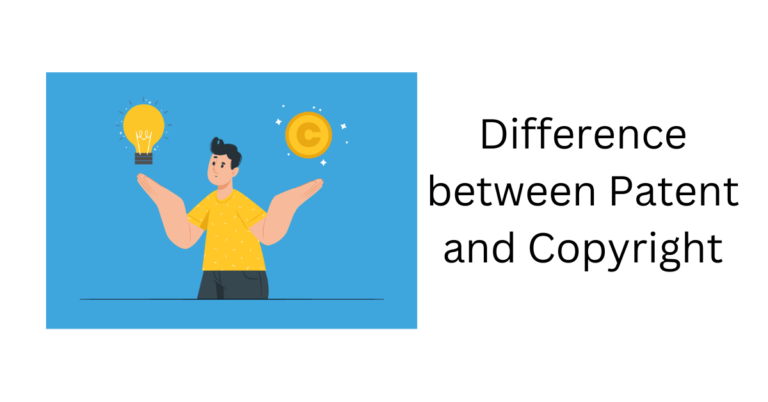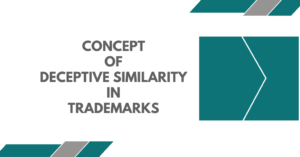The difference between Copyrights and Patents, and Trademarks is both obvious and perplexing. The trademarks and patents are part of industrial intellectual property, but copyright is a distinct kind of intellectual property in itself. A patent generally focuses on granting the inventor the exclusive right to use the patented invention/method/product. Copyright is granted to the author or creator of an original piece of work or art, and its purpose is to protect and credit the author for making his work public and accessible to others. Lastly, a trademark reflects a company’s identity, goodwill, and reputation in the market; a trademark serves as a name plate for a brand.
Let us under the difference between Trademarks, Copyrights and Patents with example, consider the following: if a person creates a pen with a scanner, the invention will be a subject of a patent; if the same person gives the pen a name and begins selling it, the name becomes a trademark; and if the same person creates a song or poem to advertise his pen, it becomes a subject for copyright protection.
However, for the purpose of this topic let us stick to understanding the difference between copyrights and patents in depth.
Patents
A patent grants the owner the legal and exclusive right to prevent any other person or company from using, manufacturing, or selling the patented invention. A patent can be granted on both the process of developing a product or invention and the final product. An innovation must satisfy three tests in order to be granted a patent.
- Novelty- This means that only inventions that have not been anticipated by the public and have not entered the public domain can be patented.
In Novartis v. Union of India, while considering the novelty of a cancer medicine, the Supreme Court of India ruled that an innovation cannot be regarded novel if it is merely an addition to what already exists.
- Inventive Step- This means that a product or process must be an innovative solution. It cannot be an obvious option to a manufacturer or anyone skilled in the same field.
- Utility or Industrial Application- Industrial application simply denotes that an invention should have some practical utility so that it can be employed in the actual world, and that it should not be something abstract or purely theoretical that cannot be put to industrial use.
In F. Hoffman-La Roche, the court provided a comprehensive definition of the term, stating that re requirement necessitates an invention’s commercial viability and that even if the invention for which a patent application is filed is not in its final form, the patent can only be granted if the invention has some commercial viability.
5 Examples of Patents in India
Susant’s breathing sensor apparatus
Invented by Susant Pattnaik, the Breathing Sensor Apparatus is a gadget that enables a totally impaired person to perform all forms of tasks that a normal human may perform by smelling or breathing.
Arun Cherian’s innovative cane prosthetic legs
Rise Legs, a Bengaluru-based startup, has developed a cane-based prosthetic limb for amputees that is not only lighter but also more inexpensive.
Anang Tadar’s Goggles For Blind
Tadar’s G4B goggles use echolocation technology, which replicates the way bats perceive their environment, to notify visually challenged wearers to items within 2 meters of their field of view.
Ashwath Hedge’s Edible Bags
EnviGreen’s bags are created from a combination of natural starch (derived from potato and tapioca) and vegetable oils; these bags biodegrade in 180 days and disappear in a day when submerged in water. Additionally, these bags are delicious. Therefore, even if animals consume these bags, they will suffer no severe impacts.
Arvind Thiagarajan’s HDFonoDoc
It is a well-known truth in the medical community that if the murmur is not recognized and treated in a timely manner, it can be fatal. HDFonoDoc is a revolutionary instrument that can detect heart murmur within 10 seconds.
Copyright
A copyright is often granted to the author or creator of an original work. It grants the owner the sole right to copy, distribute, adapt, exhibit, and perform a creative work for a set period of time. Copyright can apply to a song, a movie, a book, a course module, poetry, dance, a painting, drama, and so on. To be protected, a work must meet two essential requirements: originality and fixation. In Sanjay Soya Private Limited v. Narayani Trading Company, the Bombay High Court ruled that registration of Copyright under the Act is voluntary and at the owner’s choice, and that none of the Act’s provisions necessitate registration of Copyright prior to obtaining remedy under the Act.
- Originality implies that a work must be unique and not duplicated from elsewhere. Because the copyright law is silent on the extent of originality, the level of originality can be altered.
- Fixation implies that a work should be written down or in some physical form, rather than being only an idea. The idea is not protected by copyright law, but the expression of the idea is.
Patent Vs. Copyright
Let us understand on what aspects, the copyright and patent is different
Governing Law
- Copyright- Copyright Act,1957
- Patents- Patent Act, 1970
What is protected?
- Copyright safeguards creative works of authorship such as films, songs, poems, photographs, sketches, and so on.
- A patent protects inventions such as products, methods, machines, and any additions or upgrades to existing ones.
Eligibility Criteria for Protection
- To be eligible for copyright protection, a work must be original and fixed in a physical medium.
- To be eligible for a patent, an invention must be unique, have an inventive step, and have an industrial application.
Rights Granted
- Copyright gives the owner the exclusive right to reproduce, distribute, adapt, display, and perform a creative work.
- A patent gives the owner the legal and exclusive right to prevent anybody else from using, manufacturing, or selling the patented invention.
Exception to infringement
- Sec 52 of the Copyright Act, 1957 talks about the fair use doctrine and mentions the situations where the use of copyrighted work would not amount to copyright infringement.
- Prior Use exemption, scientific use exemption, and compulsory licensing by the government are some of the exception to the patent infringement.
Availability to Public
- A copyright is granted as a reward to the author/owner of an original work for making it available to the public.
- A patent is granted when the invention is completely disclosed to the patent office and not to the public; a patent can never be granted to an invention that is already accessible to the public.
Filing Procedure
- The patent filing procedure is lengthy and complicated, and it includes the preparation of claims, specifications, and the filing of provisional and complete applications, prior art searches, examination reports, and oppositions and hearings. A patent might take anything from 2 to 5 years to acquire.
- Copyright is a sui generis right that exists as soon as the work is created and made public; copyright registration is not required.
Term of Protection
- Copyright- Author’s life plus 60 years.
- Patent- 20 years from the day of filing.
Conclusion
In spite of the fact that the Indian laws on intellectual property provide a clear distinction between all intellectual properties, they are sure to overlap on occasion, and here is where the misunderstanding emerges, as the laws remain quiet on such instances. In India, for example, a computer code is protected as a literary work, but the same code can be patented if it is part of an invention that is both inventive and industrially applicable. Similarly, a device trademark that is an artistic work can likewise be protected by copyright. Despite these overlaps, the distinction between copyrights, patents, and trademarks is substantial and noteworthy.






